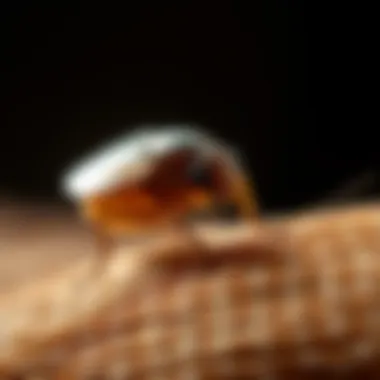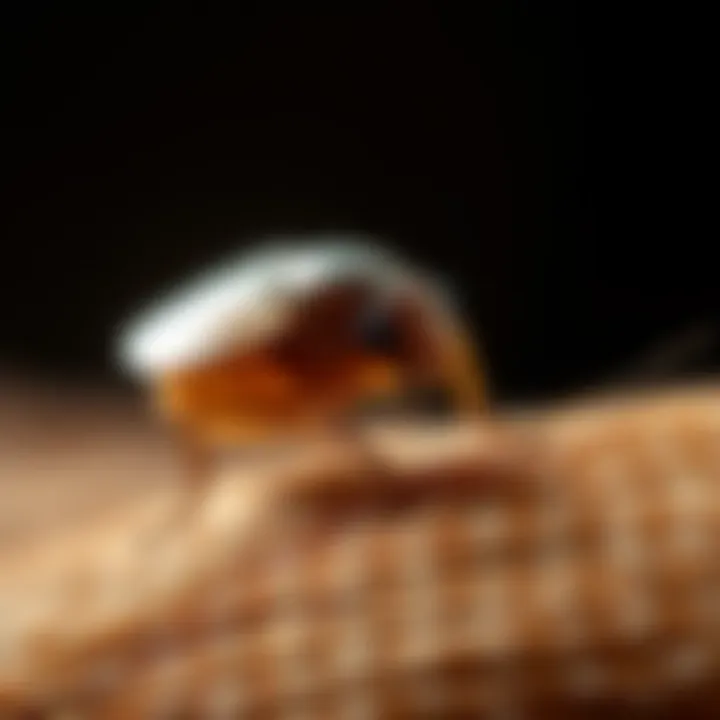Identifying Fleas in Your Home: A Comprehensive Guide


Intro
Fleas can become unwelcome guests in our homes, often arriving unnoticed and setting up shop in the most inconvenient places. Identifying the signs of a flea infestation can be crucial for maintaining a healthy living atmosphere. This article will take a thorough look at what makes these pests tick, including their behaviors and lifecycle, which can help homeowners become proactive rather than reactive. Understanding the nature of fleas goes a long way in ensuring a rigorous pest management strategy.
Understanding the Pest
Identification
Fleas are tiny, wingless insects that typically measure about 1/16 to 1/8 inch in size. Their bodies are flattened side-to-side, which allows them to navigate through the fur of their animal hosts with ease. Common types include the cat flea, dog flea, and the rat flea, all of which can pose a problem in residential areas.
To identify a flea, look for their characteristic jumping ability—or rather, prowess—in leaping as far as 150 times their own body length. They are usually reddish-brown and can be difficult to spot as they dart quickly. A useful method to detect these pests is to wear white socks and walk through areas where pets frequent. If you see small dark specks that jump around, those are likely fleas.
Life Cycle
Fleas undergo a four-stage lifecycle: egg, larva, pupa, and adult. Knowing this cycle is vital for effective management:
- Eggs: Fleas lay around 20 to 30 eggs daily, which fall off the host into the environment, including carpets and bedding.
- Larvae: After about 2 to 14 days, the larvae hatch from eggs and feed on organic matter, including adult flea feces.
- Pupae: The larvae spin cocoons and become pupae, where they can remain dormant for several months depending on environmental conditions.
- Adults: When a host approaches, they emerge to feed on blood, continuing the cycle.
Understanding this lifecycle helps homeowners realize not just the immediate need for pest control, but also the long-term measures necessary to eradicate them completely.
Pest Prevention Strategies
Environment Modification
Preventing fleas starts right at home. Cleaning is key; regular vacuuming can disrupt their lifecycle. Consider these steps to modify your environment:
- Keep yard debris to a minimum.
- Regularly wash pet bedding at high temperatures.
- Use cedar chips or diatomaceous earth in gardens and pet areas, both of which can deter fleas naturally.
Physical Barriers
Installing effective physical barriers can help stop fleas from entering your home. Check doors and windows for gaps, which could allow these pests easy access. Installing screens on windows and ensuring that doors close tightly can prove advantageous.
Control Methods
Chemical Control
If an infestation occurs, chemical treatments might become necessary. Products such as topical treatments for pets, sprays, or foggers can help manage the issue, but it's important to follow instructions carefully. Be wary of how chemicals interact with pets and kids. Always read the product labels and consider consulting professionals.
Biological Control
Alternative management strategies include biological control using nematodes or other natural predators. Beneficial nematodes can be effective when released into infested areas, seeking out flea larvae and helping break the cycle organically.
Remember, an integrated approach—using both prevention and control measures—will yield the best results in managing flea populations.
Further reading can be found at Wikipedia, National Pest Management Association, and CDC.
Understanding Fleas
Understanding fleas is fundamental for homeowners looking to maintain a healthy living environment. These tiny parasites can quickly become a nuisance, affecting not just pets but also the households they inhabit. Grasping their biology, lifecycle, and signs of infestation equips readers with the knowledge necessary to combat these unwelcome guests effectively. It’s not just a matter of keeping your home clean; it involves understanding the enemy.
Biology of Fleas
Fleas aren’t just pests; they are highly adaptable creatures that boast unique biological characteristics. Fleas belong to the order Siphonaptera, with over 2,500 species documented worldwide. These flat, wingless insects are equipped with strong legs that allow them to leap distances over 200 times their body length. That’s like a human jumping over a building! Their bodies are covered with tiny hairs and spines, making it challenging for them to be removed once they latch on to an animal or human.
What’s more, fleas have specialized mouthparts designed to pierce skin and siphon blood. Adult fleas feed solely on blood, which they must consume regularly for energy and reproduction. Their feeding habits can transmit various diseases and lead to discomfort, itching, and even allergic reactions in their hosts.
Furthermore, fleas can reproduce at an astonishing rate. A single female flea can lay up to 50 eggs a day! These eggs can fall off pets and into the environment, leading to potential infestations in homes. Understanding these biological traits is crucial in formulating strategies for prevention and control.
Lifecycle Stages
Flea infestations don’t happen overnight; they result from a gradual process with distinct stages. This lifecycle includes four critical phases: egg, larva, pupa, and adult.
- Egg: The cycle starts with the female laying eggs, usually in a pet's fur or along resting areas. These eggs are shiny and small, often not easily visible.
- Larva: Once the eggs hatch, they develop into larvae. This stage can last from a few days to several weeks, during which larvae feed on organic debris, including adult flea feces that serve as a food source.
- Pupa: After the larval stage, fleas enter a protective cocoon. This pupal stage can last several weeks or even months, depending on environmental conditions. Fleas can remain dormant until they sense a potential host nearby.
- Adult: The last phase is the adult flea, which emerges ready to feed and reproduce. The entire lifecycle can take as little as two weeks under optimal conditions.
Fleas can live up to several months without a host, making eradication a significant challenge!


Understanding these lifecycle stages provides homeowners with insight into how to tackle flea problems effectively. Identifying the stages allows for more targeted methods of control, enhancing the chances of effective treatment. By grasping the biology and lifecycle of fleas, homeowners can be proactive in their prevention efforts, ensuring their homes remain flea-free.
Identifying Flea Infestations
Identifying flea infestations is a crucial first step in managing these pesky critters in your home. Left unchecked, flea populations can balloon rapidly, leading to an uncomfortable and unhealthy living situation. By being vigilant and recognizing the signs of an infestation early, homeowners can take effective action to curb these unwelcome guests.
Fleas are not just a nuisance; they can pose health risks to both humans and pets. For instance, fleas can transmit diseases and cause allergic reactions, leading to skin irritations and discomfort. This real risk underlines the importance of knowing the signs of an infestation and the actions needed to control it.
Understanding the behavioral patterns of fleas helps in pinpointing the right moments to act. These tiny insects are adept at hiding and can multiply quickly, so homeowners should learn what to look for to identify the problem before it escalates. With a keen eye and careful inspection, you can mitigate the risk fleas pose to your household.
Common Signs of Fleas
Recognizing the signs of fleas is critical. Here are some common indicators:
- Flea Dirt: One of the easiest ways to know if fleas are present is by spotting flea dirt, which looks like small black pepper-like specks. This is typically flea feces and can often be found where pets rest.
- Visible Fleas: Fleas are small but not invisible. If you notice tiny brownish insects hopping on your pets or around the house, it’s time to take a closer look.
- Scratching and Irritability in Pets: If your pets are scratching more than usual or appear restless, it may be due to flea bites. Fleas can cause severe discomfort, leading to constant scratching or biting at the skin.
- Skin Irritation: Look for red, inflamed patches of skin on pets or even family members. Flea bites can lead to allergic reactions and skin conditions.
- Flea Eggs: Flea eggs are tiny, white, and oval-shaped. They can easily fall off pets and may be found on pet bedding, carpets, or where pets frequently hang out.
If you notice one or more of these signs, prompt action is essential. Ignoring them can lead to a full-blown infestation that is much harder to tackle.
Behavioral Patterns of Fleas
Fleas exhibit certain behavioral patterns that can help in identifying their presence:
- Jumping Ability: Fleas are renowned for their jumping ability. They can leap about 150 times their body length. If you see what seems to be a speck of dirt moving or hopping in your carpets or on your pet’s fur, it could very likely be a flea.
- Night and Day Activity: Fleas are most active at night, but they can also be found during the day, especially in warm, humid conditions. Understanding their active hours can aid in effective detection.
- Hiding Places: Fleas like to hang out in dark, warm places. Common hiding spots include under furniture, in the crevices of carpets, and in bedding. A thorough inspection of these areas can reveal hidden fleas and their larvae.
- Social Behavior: Fleas are parasitic and often clustered together. If you spot one, it’s likely that more are lurking nearby. Check not just the spot you see fleas, but surrounding areas too.
Being aware of these patterns helps sharpen your focus during inspections, making it easier to trace back to potential sources of infestation.
By staying alert and knowledgeable about identification techniques, you can effectively manage fleas and protect your home from the discomfort and health risks they bring.
Assessing Your Home for Fleas
Assessing your home for fleas is a crucial step in managing these pesky intruders. The importance of this process cannot be overstated, especially when considering the health risks fleas pose to both humans and pets. Taking the time to evaluate your living space not only helps to minimize discomfort but ensures a healthier environment overall. Fleas can multiply at an alarming rate, so early detection is key in preventing a full-blown infestation.
Initial Inspection Checklist
Before diving deep into the nooks and crannies, it’s essential to arm yourself with a basic inspection checklist. This will help streamline your efforts and ensure no stone is left unturned. Here are some steps to guide your initial inspection:
- Look for flea droppings: Black specks known as flea dirt can usually be found in pet areas or resting spots. If you see small flecks that turn reddish-brown when wet, that's a sure sign!
- Check pets: Look closely at your furry friends, especially around the neck, tail, and belly where fleas often congregate. Use a fine-toothed comb to catch any hidden fleas.
- Inspect your floor: Examine carpets, rugs, and bare floors. Fleas like dark and moist places, which makes these areas prime real estate for them.
This checklist serves as a foundational tool that can guide your inspection process and help identify potential flea hotspots in your home.
Special Attention Areas
When assessing your home, some areas deserve a touch more scrutiny. Fleas thrive in particular spots, so knowing where to look can save you a lot of headaches down the road.
Carpets and Rugs
Household carpets and rugs present a cozy habitat for fleas. They can nestle deep into the fibers, making them difficult to spot. The key characteristic of carpets is that they provide warmth and a hidden space where flea eggs and larvae can develop without disturbance. In this article, paying special attention to such areas can go a long way in identifying flea problems early.
However, cleaning carpets is a double-edged sword. While regular vacuuming can disrupt flea development and prevent infestations, ineffective cleaning methods might leave behind these pests. Consider this as an essential part of maintaining a flea-free home environment.
Pet Sleeping Areas
Pet sleeping areas are like a five-star hotel for fleas. These spots often contain the warmth and scent that fleas are attracted to, thus making them a breeding ground. A key detail here is that these areas might not just include bedding but also favorite corners or spots where pets frequently lounge.
Special attention to pet sleeping areas can reveal flea activity that may not have been obvious before. Washing pet bedding regularly can help disrupt the flea lifecycle. Keep in mind that letting your guard down in this category can quickly lead to a full-fledged infestation.
Soft Furnishings
Whether it’s a favorite couch or plush chairs, soft furnishings are another hotspot for flea activity. Fleas can easily hide in seams and folds, making detection harder. The unique characteristic of soft furnishings is that they offer both concealment and comfort for fleas, allowing them to thrive without being spotted.
For this article, understanding the peculiarities of soft furnishings becomes paramount. Regularly inspecting and cleaning these items is critical in preventing any unwanted critters from setting up camp. If left unchecked, they could essentially become breeding grounds, costing you both money and peace of mind.
Articulating these specific aspects of assessing your home allows homeowners to take charge of their living spaces, ensuring that fleas don’t make an unwelcome return.
Flea Detection Techniques
Flea detection techniques are pivotal for any homeowner who wishes to gain the upper hand in a battle against fleas. Detecting these pests at an early stage allows for quicker and more efficient control measures. Ignoring signs of flea infestation can lead to a small problem blossoming into a full-blown infestation, which can wreak havoc on your living space and negatively impact the health of your pets and family members. By familiarizing yourself with effective detection methods, you'll be better equipped to maintain a flea-free home.


Visual Examination Methods
Carrying out a visual examination is a straightforward yet essential step in the flea detection process. Paying attention to specific areas of your home can enhance your chances of spotting these unwelcome visitors. Here’s how to effectively conduct this examination:
- Check Your Pets: Start with your furry companions, as they are often the first point of contact for fleas. Look closely at their skin, especially around the neck and base of the tail. Fleas themselves are hard to spot, but flea dirt—tiny black specks that are the flea’s feces—can give you a strong indicator of their presence. Place the dirt on a damp paper towel; if it turns reddish-brown, it's likely flea dirt.
- Inspect Bedding and Soft Furnishings: Don't forget about the areas where your pets sleep. Thoroughly check their bedding for signs of fleas or dirt. For soft furnishings like couches or chairs, lift cushions and inspect seams and folds where fleas like to hide.
- Search Common Hiding Spots: Fleas have a penchant for dark, confined spaces. Be vigilant and check corners of rooms, behind furniture, under carpets, and even in cracks in the floorboards.
These examinations are not merely about spotting adult fleas; they're about gathering intel that will help you strategize effectively against further infestation.
Flea Traps and Monitors
Sometimes, you may need extra assistance to confirm your flea suspicions. This is where flea traps and monitors enter the scene, proving invaluable for tracking flea activities more systematically.
- DIY Flea Traps: Creating a simple flea trap requires very little in terms of materials. All you need is a shallow dish filled with soapy water and a light source. Set the trap in areas where you've noticed activity, such as near pet beds or walking paths. The light attracts fleas, which then leap into the soapy water, unable to escape.
- Commercial Flea Monitors: For those who prefer a ready-made solution, various commercially available flea traps can streamline the detection process. These often use pheromones to lure fleas in, making them highly effective in catching fleas in your vicinity. By placing these traps strategically throughout your home, you can monitor flea populations over time.
Utilizing both visual examinations and traps can form a robust strategy for detecting flea infestations in your home. The combination of these methods not only enhances the likelihood of finding fleas but also empowers you with the knowledge necessary to take decisive action.
Impact of Fleas on Health
Understanding the health implications of fleas is crucial for homeowners and pet owners alike. Fleas are not just a nuisance; they can pose considerable health risks to both humans and pets. Recognizing these potential dangers empowers you to take preemptive measures against infestations and their consequences. By grasping the extent of these health impacts, you can make informed decisions on pest control and maintain a safe living environment.
Health Risks for Humans
Fleas can transmit diseases to humans, which is often underestimated. One major concern is the risk of allergic reactions. Some individuals may develop flea allergy dermatitis if bitten, leading to intense itching, rash, and inflammation. Moreover, fleas can carry parasites like the tapeworm, which humans can accidentally ingest through contact with infested pets or contaminated surfaces.
Fleas are not just about bites. They can cause illnesses such as murine typhus, which is rare but serious, transmitted through flea feces. This disease can lead to fever, chills, and rash. Also, in areas where fleas are prevalent, there’s the potential for zoonotic diseases circulating among even domestic environments.
Here are some notable risks for humans:
- Flea Bites: They can lead to swelling, itching, and sometimes an allergic response.
- Disease Transmission: Serious illnesses may arise, including typhus and tularemia.
- Psychological Effects: Simply the presence of fleas can lead to anxiety and stress in a household.
In neglecting flea control, you may not only live with discomfort but also open doors to more serious health challenges.
Risks for Pets
For pets, the consequences of a flea infestation can be dire. Fleas can cause similar allergic reactions in animals as in humans. Pets, especially dogs and cats, can develop flea allergy dermatitis, leading to excessive scratching and self-trauma. Their skin could become infected, resulting in a much tougher situation than just being uncomfortable.
Moreover, fleas are vectors for parasites. An infected flea can transmit tapeworms to pets, leading to weight loss, digestive issues, and discomfort. Furthermore, the infant flea stages can wreak havoc on young puppies and kittens whose immune systems are still developing.
Some other key risks for pets include:
- Anemia: Severe infestations can result in blood loss, leading to weakness, lethargy, and at times, a life-threatening situation, particularly for small animals or younger ones.
- Infection: Open sores from scratching can become infected, requiring veterinary care.
- Behavioral Changes: Persistent irritation can result in behavioral issues, such as withdrawal or increased aggression due to constant discomfort.
Taking the health risks posed by fleas seriously ensures a happy and healthy home for both you and your pets.
Effective Flea Control Measures
Dealing with fleas is not just about recognizing their presence; it’s also about acting decisively to manage and eliminate them. Effective flea control measures are paramount in safeguarding your home and your pets from health risks and everyday irritations caused by these pests. These measures can mitigate flea populations significantly, ensuring that infestations don't spiral out of control. Even if you've managed to eliminate a flea problem once, the real challenge lies in preventing their return. Understanding the best techniques available can be the difference between a home that's flea-free and one that has persistent infestations.
Insecticides and Treatments
When it comes to flea control, insecticides play a key role. Many products are available on the market today, often specially formulated for home use. Understanding what to look for can make the process a whole lot easier. Here are a few important things to consider:
- Type of Insecticide: You’ll find two main types—adulticides, which kill adult fleas, and insect growth regulators (IGRs), which prevent the maturation of larval fleas. Utilizing both can significantly enhance effectiveness.
- Application Method: Sprays, powders, and foggers each have their pros and cons. Sprays target immediate areas, while powders can penetrate carpets. Foggers cover large areas but can be trickier to use in tighter spaces.
- Safety Considerations: Always read labels carefully. It’s crucial to ensure the product is safe for use around pets and children. Pay attention to any warnings and recommended re-entry times to prevent health risks.
One example of an effective insecticide is Frontline Plus, which not only kills adult fleas but also addresses ticks and other pests. Alternatively, Advantage II is known for its quick action against fleas and its effectiveness in preventing future infestations. Remember to apply these treatments strictly as per the manufacturer's guidelines for optimal results.
Natural and Eco-Friendly Solutions
For those who prefer a gentler approach, several natural and eco-friendly solutions can be employed to manage flea populations. This is especially important for households with small children or pets sensitive to chemicals. Here are some notable methods:
- Diatomaceous Earth: This powdery substance is derived from fossilized algae. It works effectively against fleas by dehydrating them upon contact. By sprinkling it in areas where fleas are likely to roam, you create a natural barrier.
- Essential Oils: Certain oils, such as lavender and cedarwood, can repel fleas. Mixing a few drops with water and spraying it in your home can discourage fleas from taking up residence.
- Homemade Flea Traps: A simple trap can be made using a bowl of soapy water placed under a lamp. The light attracts fleas, and the soap prevents them from escaping, effectively reducing their numbers.
"The best strategy combines both immediate action and ongoing preventative measures. Systematically using insecticides along with natural strategies can lead to a flea-free home environment."
Combining traditional insecticide approaches with natural methods not only fortifies your fight against fleas but also promotes a healthier living environment. It's about setting up a comprehensive, multi-faceted strategy that ensures success over time. By choosing the right methods and products tailored to your needs, you can reclaim your space from fleas and feel at ease in your own home.


Associated Resources
For further information and tips on flea control measures, consider visiting these resources:
Preventing Future Infestations
Preventing fleas from taking up residence in your home is a crucial part of maintaining a healthy living space. Fleas are not just a nuisance; they can lead to health issues for both humans and pets. As such, investing time and effort into prevention can save you significant trouble down the line. Not only does a proactive approach reduce the risk of infestations, but it also helps create a more comfortable environment for you and your family.
Maintaining Clean Living Spaces
A clean home is your first line of defense against fleas. Regular cleaning can effectively disrupt the lifecycle of these pests and reduce their chances of establishing a foothold in your home. Here are some practical tips to keep in mind:
- Vacuuming Regularly: Frequent vacuuming is essential. Focus on areas where pets spend most of their time, such as carpets, rugs, and soft furnishings. Make sure to dispose of the vacuum bag or empty the canister outside to prevent re-infestation.
- Washing Bedding and Fabrics: All pet bedding, blankets, and even your own sheets can host flea eggs and larvae. Wash these in hot water once a week. Heat helps in killing any potential eggs or larvae lurking within the fabric fibers.
- Decluttering Your Home: Fleas love to hide in cluttered spaces. Reducing unnecessary items not only helps in cleaning but also makes it easier to spot any signs of fleas.
- Outdoor Maintenance: If you have a yard, keep it tidy. Trim tall grasses and bushes where fleas can thrive, and consider using outdoor flea treatments if needed.
"Prevention is better than cure! Keeping your spaces clean means fewer surprises later on."
Implementing these practices can significantly lessen the opportunity for fleas to move in.
Regular Pet Care Practices
Your pets are often the primary carriers of fleas. Thus, ensuring they receive proper care is vital in keeping your home flea-free. Here are essential steps to consider:
- Routine Bathing: Give your pets regular baths with flea shampoos, especially during warmer months when fleas are most active. This reduces the likelihood of your pets bringing fleas indoors.
- Use Flea Preventatives: There are various products on the market, such as topical treatments, collars, and oral medications. Consult with your veterinarian to find the right solution for your pets’ specific needs.
- Regular Check-ups: Schedule yearly vet visits to keep track of your pet's overall health. A healthy pet is less likely to struggle with flea infestations. During these visits, ask about flea control options tailored to your environment.
- Grooming: Regularly brushing your pets not only helps you spot any fleas or flea debris but also allows for the removal of any eggs and larvae before they can spread in your home.
By putting these pet care practices into play, you can mitigate the risks of flea infestations.
Combining clean living spaces with diligent pet care forms a sturdy shield against fleas. It’s not just about immediately combating the issue, but laying a strong foundation to prevent potential pests from ever setting foot in your abode.
When to Seek Professional Help
Flea infestations can be a deeply unsettling issue for any homeowner. While many might feel tempted to handle an infestation independently, understanding when to draw the line and call in the professionals is key to maintaining a safe and comfortable home.
It's important to recognize that some situations merit the expertise of pest control specialists. These professionals not only bring advanced knowledge but also tools that are unavailable to the average person. Here’s why seeking help is crucial:
- Comprehensive Inspection: Professionals can conduct thorough inspections that go well beyond the basic methods. They are trained to locate hidden flea breeding grounds that might go unnoticed -- think cracks in the flooring or spaces behind appliances.
- Targeted Treatment Options: Many homeowners are unaware of the variety of treatments available. A pest control service can tailor their approach based on the severity of the infestation and your specific living condition. For example, if the infestation is extensive, they might recommend a combination of chemical and non-chemical methods.
- Preventive Measures: After the initial infestation is dealt with, it’s crucial to implement preventive strategies. Pest control experts can provide guidance on minimizing future infestations, such as recommending the right kinds of cleaning products or pet treatments.
Recognizing these elements can save time, effort, and perhaps most importantly, prevent you from exacerbating the situation with ineffective home remedies.
Signs of Severe Infestation
When dealing with fleas, it can be tough to know exactly how bad the problem is. Identifying signs of a severe infestation early on is essential to resolve the issue before it spirals out of control. Common indicators include:
- Increased Bites: If residents notice a rise in bites, particularly on the ankles or lower legs, it’s a red flag. Fleas are notoriously agile and may target humans before pets, especially in collaborative living situations.
- Visible Presence: Spotting fleas jumping around, especially against contrasting backgrounds like carpets or light-colored furniture, can signify an infestation.
- Flea Dirt: Finding small black specks—flea dirt—on your pets or in their resting areas indicates a significant problem. This is a telltale sign of flea feeding habits; it’s essentially digested blood.
Catching these signs promptly will help in assessing the infestation's scale and determining if professional aid is necessary.
Choosing a Pest Control Service
When it comes to selecting the right pest control service, a few key factors should be weighed carefully. Not all services are created equally, and the choice can have long-lasting effects on both your home and your wallet. Here’s what to consider:
- Research: Start by checking online reviews or asking friends and family for recommendations. Websites like Reddit can be useful for personal experiences sharing.
- Certifications and Training: Verify that the technicians are licensed and certified. This means they have undergone proper training and have a deeper understanding of pest control methods.
- Safety Practices: Make sure the company emphasizes safety, especially if you have children or pets. Inquire about the chemicals they use and if they offer eco-friendly options.
- Service Guarantee: Look for companies that offer some guarantee on their work. This can provide peace of mind in case the infestation returns after treatment.
By doing your homework and taking these factors into account, you can feel more confident that you've made an informed choice when seeking out professional help for flea control.
The End
In closing, this discussion wraps up everything vital concerning fleas and their presence in your home. Acknowledging the issues caused by these pesky critters is the first step toward creating a comfortable living space. Fleas don’t just bother pets; they can affect the entire household. As we’ve explored, identifying an infestation early on saves time, effort, and even protect your health. Healthy prevention strategies are essential, so homeowners should consistently monitor their environment.
It's crucial to remember that fleas thrive in warm, dark, and shaded areas, so keeping your living spaces well-lit and tidied up can be a deterrent.
This article has emphasized several key aspects:
Recap of Key Points
- Biology and Lifecycles: Understanding flea biology and life cycles provides context for their persistence in our homes. Each stage from egg to adult has unique identification markers.
- Signs of Infestation: Recognizing common signs of fleas like bites on skin, flea dirt, and (for pet owners) excessive scratching is critical. These details serve as a crucial alert for early intervention.
- Detection Techniques: Visual inspections and flea traps allow homeowners to confirm the presence of fleas, delineating the infestation's extent.
- Health Impacts: Both humans and pets can face significant health issues due to fleas. Awareness of these risks reinforces the necessity for immediate action.
- Effective Management and Prevention: Our examination of chemical and natural solutions illuminates various pathways to control and prevent future infestations. Ensuring a clean environment is non-negotiable.
Final Recommendations
- Regular Monitoring: Keep an eye on your pet's behavior and regularly check for fleas using a fine-toothed comb. If you notice scratching or signs of irritation, act fast.
- Implementing Control Measures: Choose a strategy that aligns with your values, whether that’s going the chemical route with brands like Frontline or opting for natural solutions like Diatomaceous Earth.
- Create a Cleaning Schedule: Regular cleaning of bedding, carpets, and other soft furnishings is indispensable.
- Prioritize Pet Care: Fleas love pets, so regular grooming and bathing with appropriate flea control products are essential to keeping them at bay.
- Education and Awareness: Lastly, staying informed about fleas’ behaviours and environmental preferences empowers you to take proactive measures. You can visit websites like CDC or EPA for more detailed insights and resources related to pest control.
By weaving these strategies into your routine, maintaining a flea-free environment becomes a feasible goal. Leaving no stone unturned ensures peace of mind knowing that your home remains a sanctuary, free from the uncomfortable presence of fleas.







